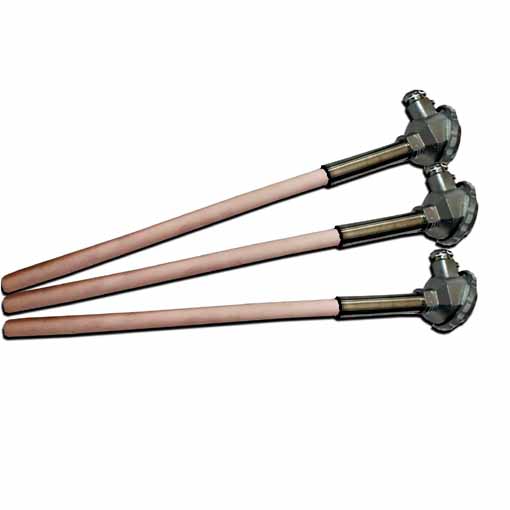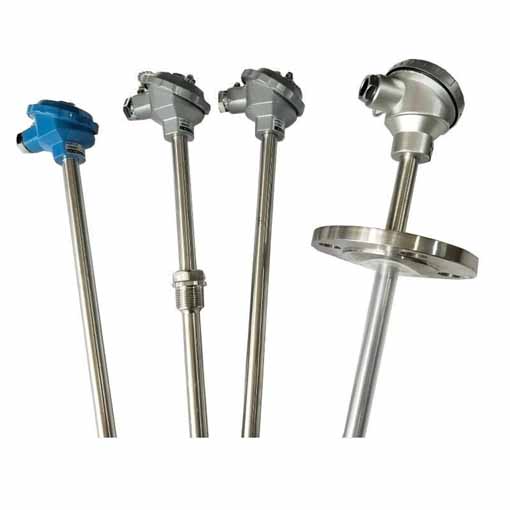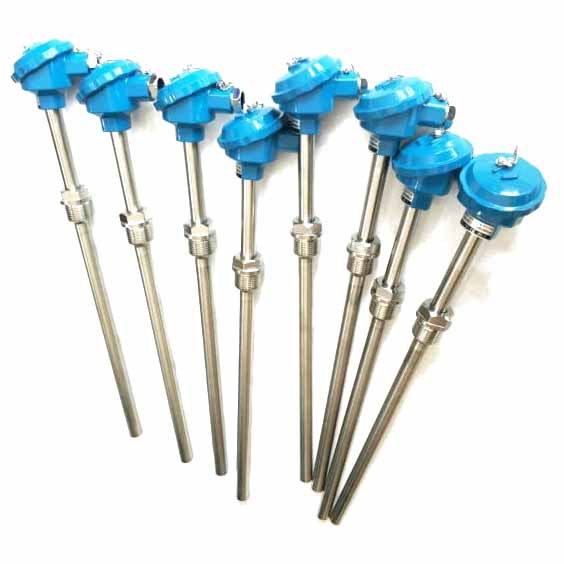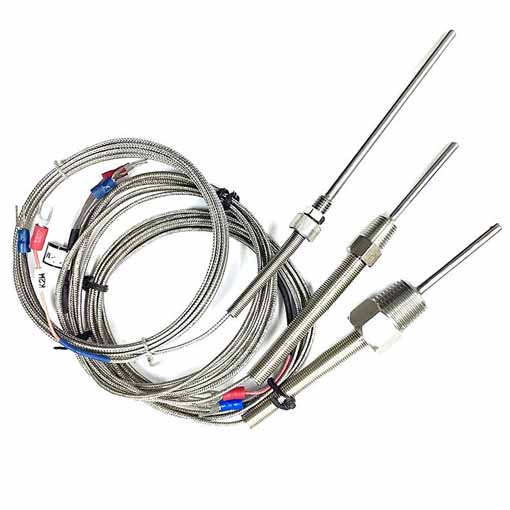Classification and thermal response time of thermocouples
Commonly used thermocouples can be divided into two categories: standard thermocouples and non-standard thermocouples. Seven standardized thermocouples of S, B, E, K, R, J, T are uniformly designed thermocouples. The so-called standard thermocouple refers to the thermocouple whose thermoelectric power and temperature are specified in the national standard, the allowable error, and the thermocouple has a unified standard graduation table. It has its matching display instrument for selection. Non-standardized thermocouples are inferior to standardized thermocouples in the scope of use or order of magnitude, and there is generally no unified indexing table, which is mainly used for measurement in some special occasions. Thermocouples and thermal resistances are all produced in accordance with IEC international standards.
Theoretically, any two different conductors (or semiconductors) can be made into thermocouples, but as a practical temperature measuring element, there are many requirements for it. In order to ensure reliability in engineering technology and sufficient measurement accuracy, not all materials can form thermocouples. Generally, the basic requirements for the electrode materials of thermocouples are:
1. In the temperature measurement range, the thermoelectric properties are stable, do not change with time, have sufficient physical and chemical stability, and are not easy to be oxidized or corroded;
2. The temperature coefficient of resistance is small, the conductivity is high, and the specific heat is small;
3. The thermoelectric potential generated during temperature measurement should be large, and the relationship between thermoelectric potential and temperature is linear or close to linear single value function;
4. The material has good reproducibility, high mechanical strength, simple manufacturing process and low price.
As the main temperature measurement method, thermocouples have a wide range of uses, so there are many requirements for fixed devices and technical performance. Therefore, there are six types of thermocouple fixing devices: Without fixing device type, Threaded, Fixed flange type, Movable flange type, Movable flange square form, There are six types of conical protection tube.
2. Classified by assembly and structure
According to the performance of the thermocouple, the structure can be divided into: Detachable thermocouples, flameproof thermocouples, armored thermocouples and compression spring fixed thermocouples and other special-purpose thermocouples.
Due to the complexity of the device, only a handful of units currently have this set of equipment. Therefore, the national standard stipulates that the manufacturer is allowed to negotiate with the user, and other test methods can be used, but the data given must indicate the test conditions.
Because the thermoelectric potential of type B thermocouple is very small near room temperature, the thermal response time is not easy to measure. Therefore, the national standard stipulates that the thermoelectrode assembly of the S-type thermocouple of the same specification can be used to replace its own thermoelectrode assembly, and then the test can be carried out.
During the test, record the output change of the thermocouple to the time T0.5 equivalent to 50% of the temperature step change. If necessary, the thermal response time T0.1 with a 10% change and the thermal response time T0.9 with a 90% change can be recorded. The recorded thermal response time should be the average value of at least three test results in the same test, and the deviation of each measurement result from the average value should be within ±10%. In addition, the time required to form a temperature step change should not exceed one-tenth of the T0.5 of the thermocouple being tested. The response time of the recording instrument or meter should not exceed one-tenth of the T0.5 of the thermocouple under test.
|
Thermocouple indexing number
|
Thermoelectrode material
|
|
|
positive electrode
|
negative electrode
|
|
|
S
|
Platinum rhodium 10
|
Pure platinum
|
|
R
|
Platinum rhodium 13
|
Pure platinum
|
|
B
|
Platinum rhodium 30
|
Platinum rhodium 6
|
|
K
|
Nickel chromium
|
Nickel Silicon
|
|
T
|
Pure copper
|
Copper nickel
|
|
J
|
iron
|
Copper nickel
|
|
N
|
NiCrSi
|
Nickel Silicon
|
|
E
|
Nickel chromium
|
Copper nickel
|
Theoretically, any two different conductors (or semiconductors) can be made into thermocouples, but as a practical temperature measuring element, there are many requirements for it. In order to ensure reliability in engineering technology and sufficient measurement accuracy, not all materials can form thermocouples. Generally, the basic requirements for the electrode materials of thermocouples are:
1. In the temperature measurement range, the thermoelectric properties are stable, do not change with time, have sufficient physical and chemical stability, and are not easy to be oxidized or corroded;
2. The temperature coefficient of resistance is small, the conductivity is high, and the specific heat is small;
3. The thermoelectric potential generated during temperature measurement should be large, and the relationship between thermoelectric potential and temperature is linear or close to linear single value function;
4. The material has good reproducibility, high mechanical strength, simple manufacturing process and low price.
Classification of fixing methods of thermocouples
1. Classified according to the type of fixing deviceAs the main temperature measurement method, thermocouples have a wide range of uses, so there are many requirements for fixed devices and technical performance. Therefore, there are six types of thermocouple fixing devices: Without fixing device type, Threaded, Fixed flange type, Movable flange type, Movable flange square form, There are six types of conical protection tube.
2. Classified by assembly and structure
According to the performance of the thermocouple, the structure can be divided into: Detachable thermocouples, flameproof thermocouples, armored thermocouples and compression spring fixed thermocouples and other special-purpose thermocouples.
Thermal response time of thermocouple
The thermal response time is more complicated, and different test conditions will have different measurement results. This is because it is affected by the heat transfer rate between the thermocouple and the surrounding medium. If the heat transfer rate is high, the thermal response time is short. In order to make the thermal response time of thermocouple products comparable, the national standard stipulates that the thermal response time should be performed on a dedicated water flow test device. The water flow speed of the device should be maintained at 0.4±0.05m/s, the initial temperature should be within the range of 5-45℃, and the temperature step value should be 40-50℃. During the test, the temperature change of the water should not exceed ±1% of the temperature step value. The insertion depth of the tested thermocouple is 150mm or the designed insertion depth (choose the smaller value and indicate it in the test report).Due to the complexity of the device, only a handful of units currently have this set of equipment. Therefore, the national standard stipulates that the manufacturer is allowed to negotiate with the user, and other test methods can be used, but the data given must indicate the test conditions.
Because the thermoelectric potential of type B thermocouple is very small near room temperature, the thermal response time is not easy to measure. Therefore, the national standard stipulates that the thermoelectrode assembly of the S-type thermocouple of the same specification can be used to replace its own thermoelectrode assembly, and then the test can be carried out.
During the test, record the output change of the thermocouple to the time T0.5 equivalent to 50% of the temperature step change. If necessary, the thermal response time T0.1 with a 10% change and the thermal response time T0.9 with a 90% change can be recorded. The recorded thermal response time should be the average value of at least three test results in the same test, and the deviation of each measurement result from the average value should be within ±10%. In addition, the time required to form a temperature step change should not exceed one-tenth of the T0.5 of the thermocouple being tested. The response time of the recording instrument or meter should not exceed one-tenth of the T0.5 of the thermocouple under test.
 |
 |
| S type ceramic thermocouple WRP WRR WRQ | R class high temperature thermocouple platinum rhodium |
 |
 |
| Class B non-standard thermocouple | K-type thermocouple PT10 temperature sensor |





